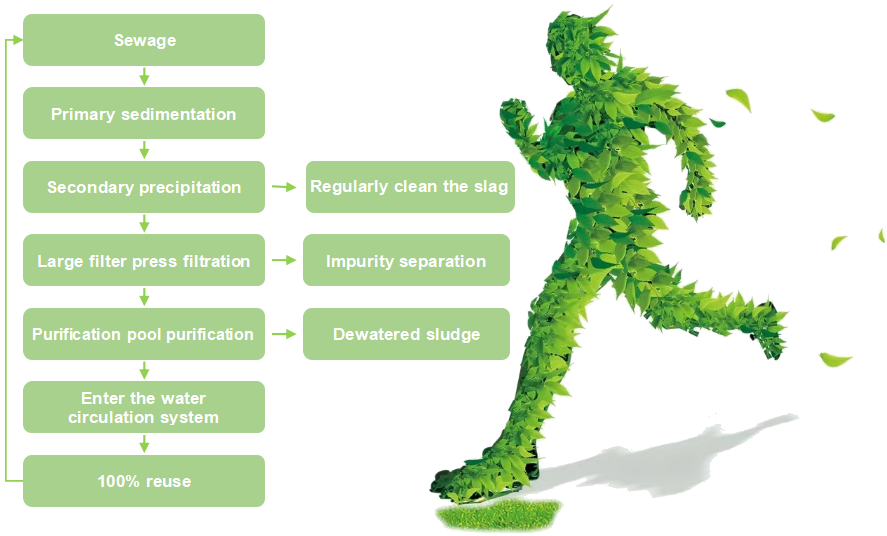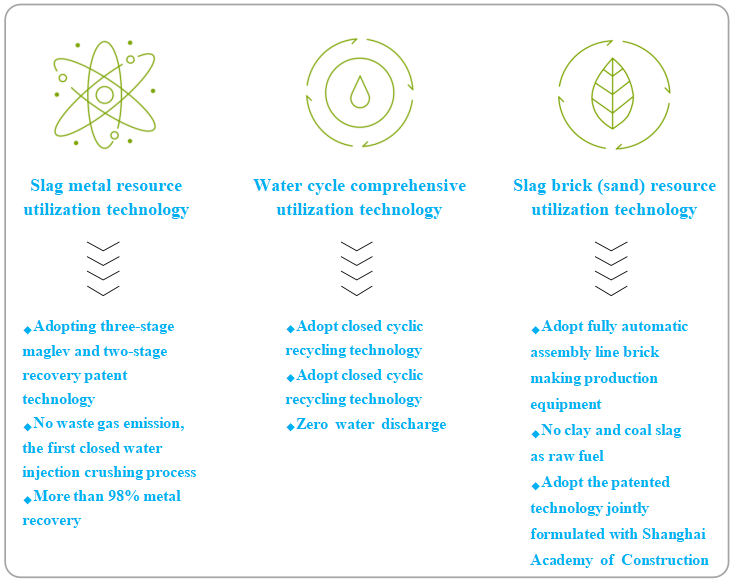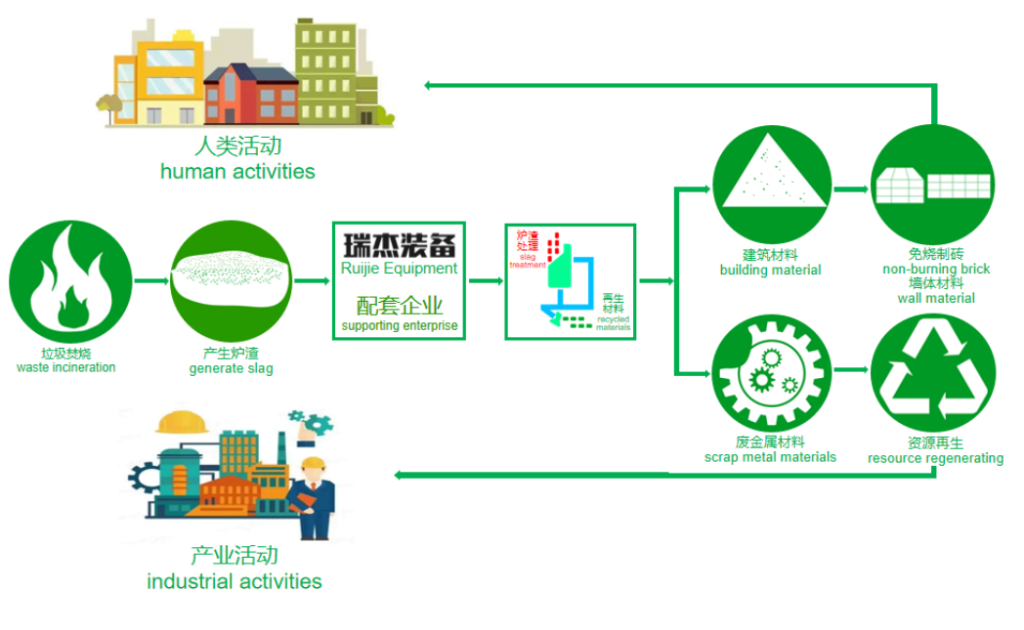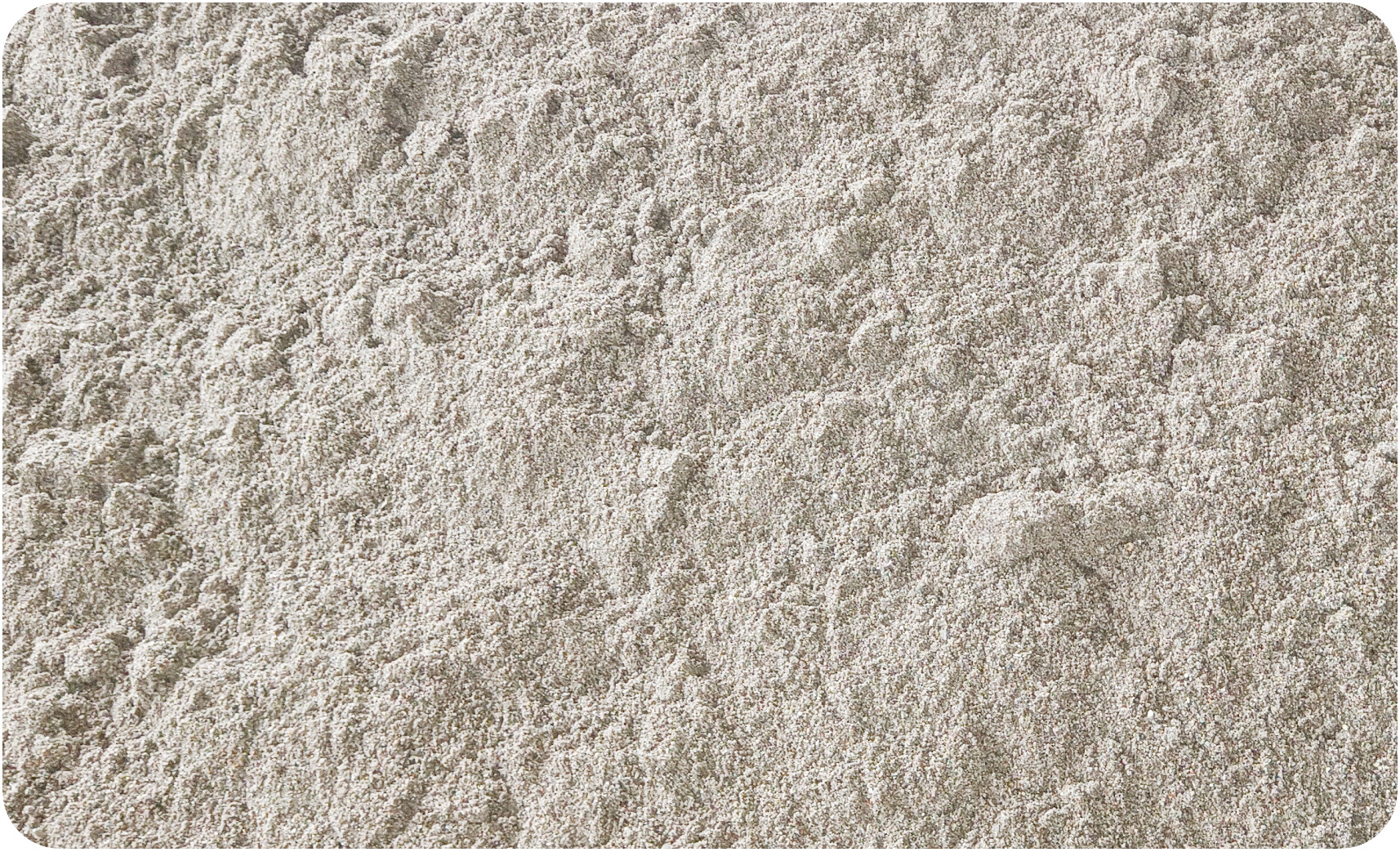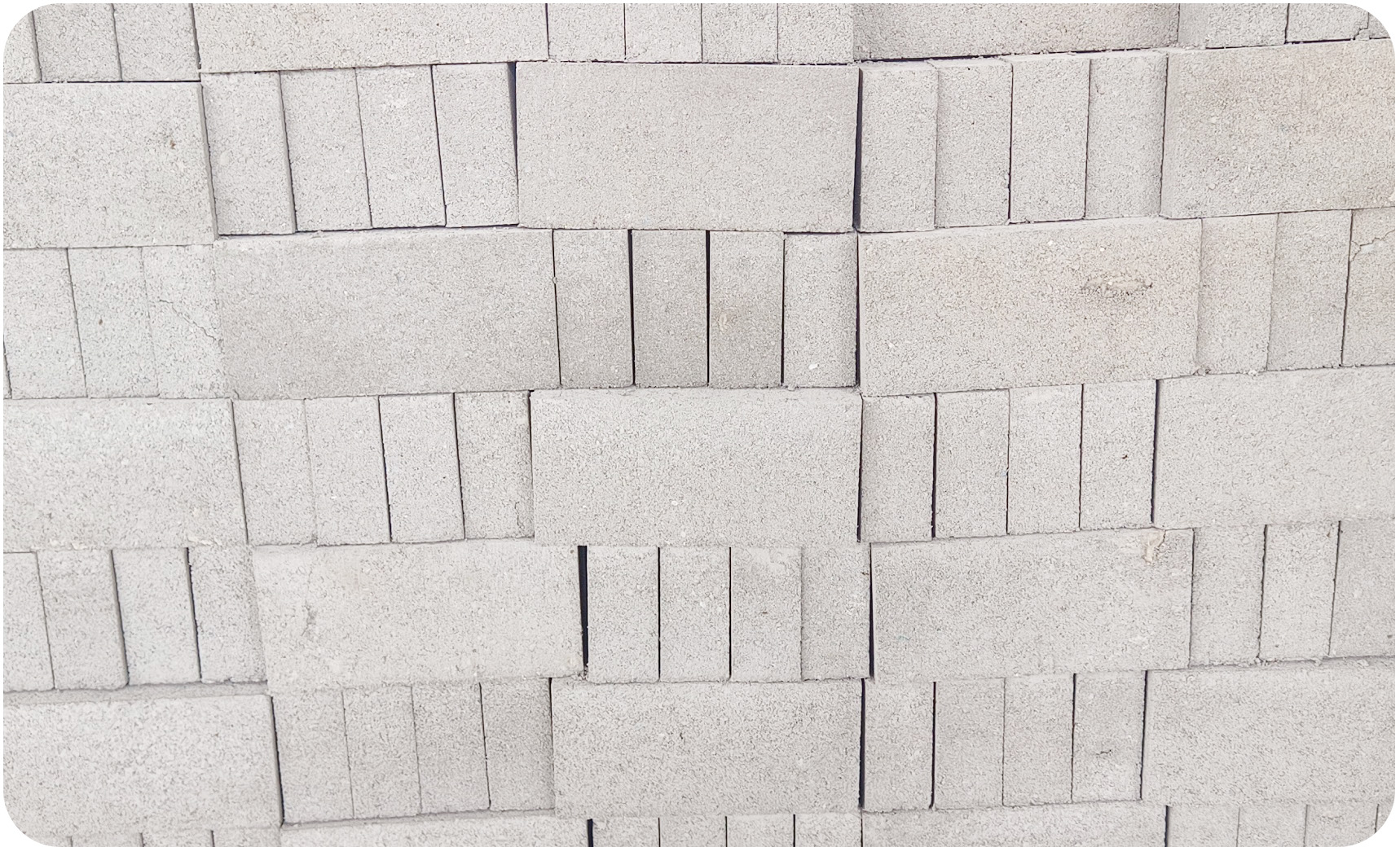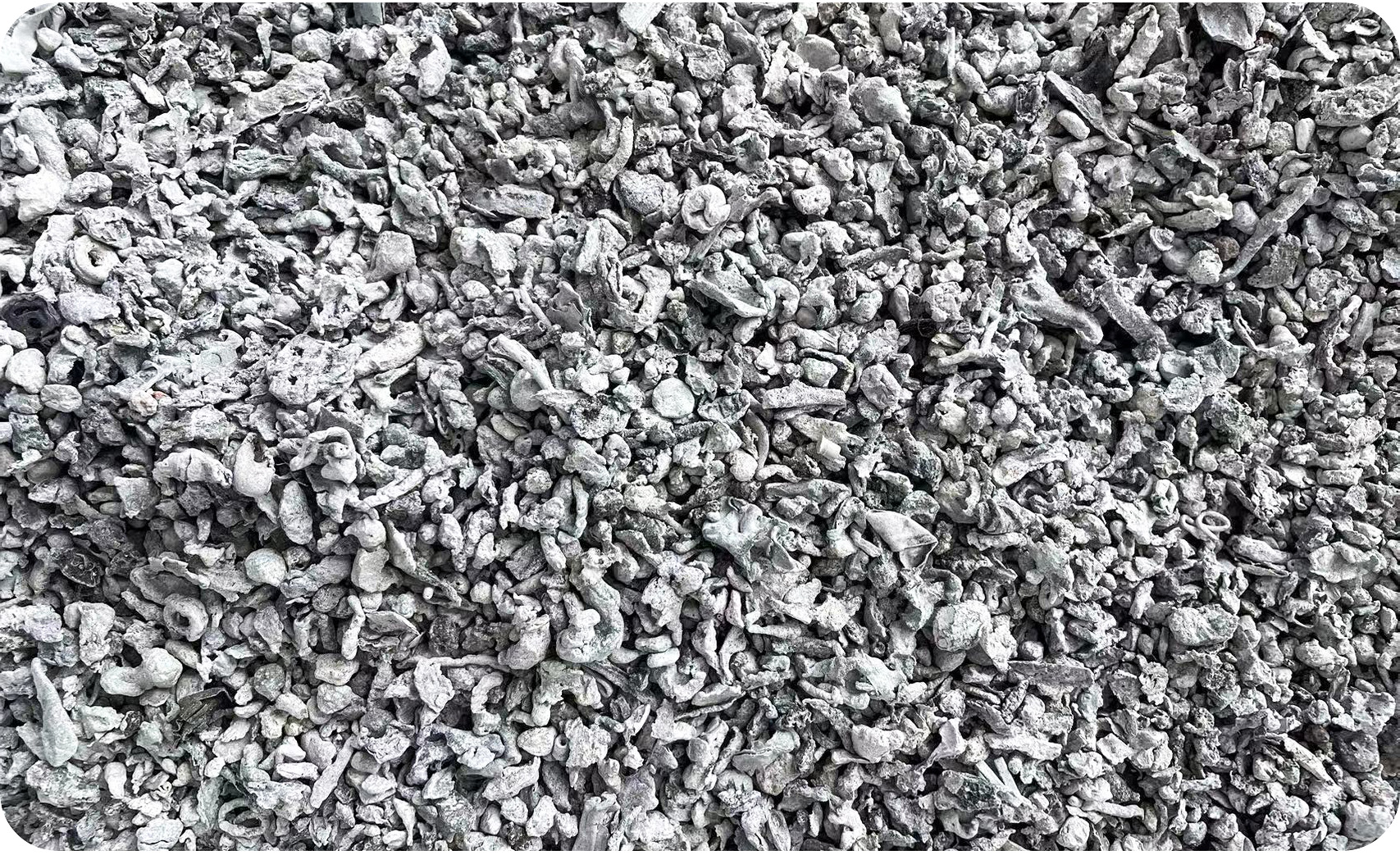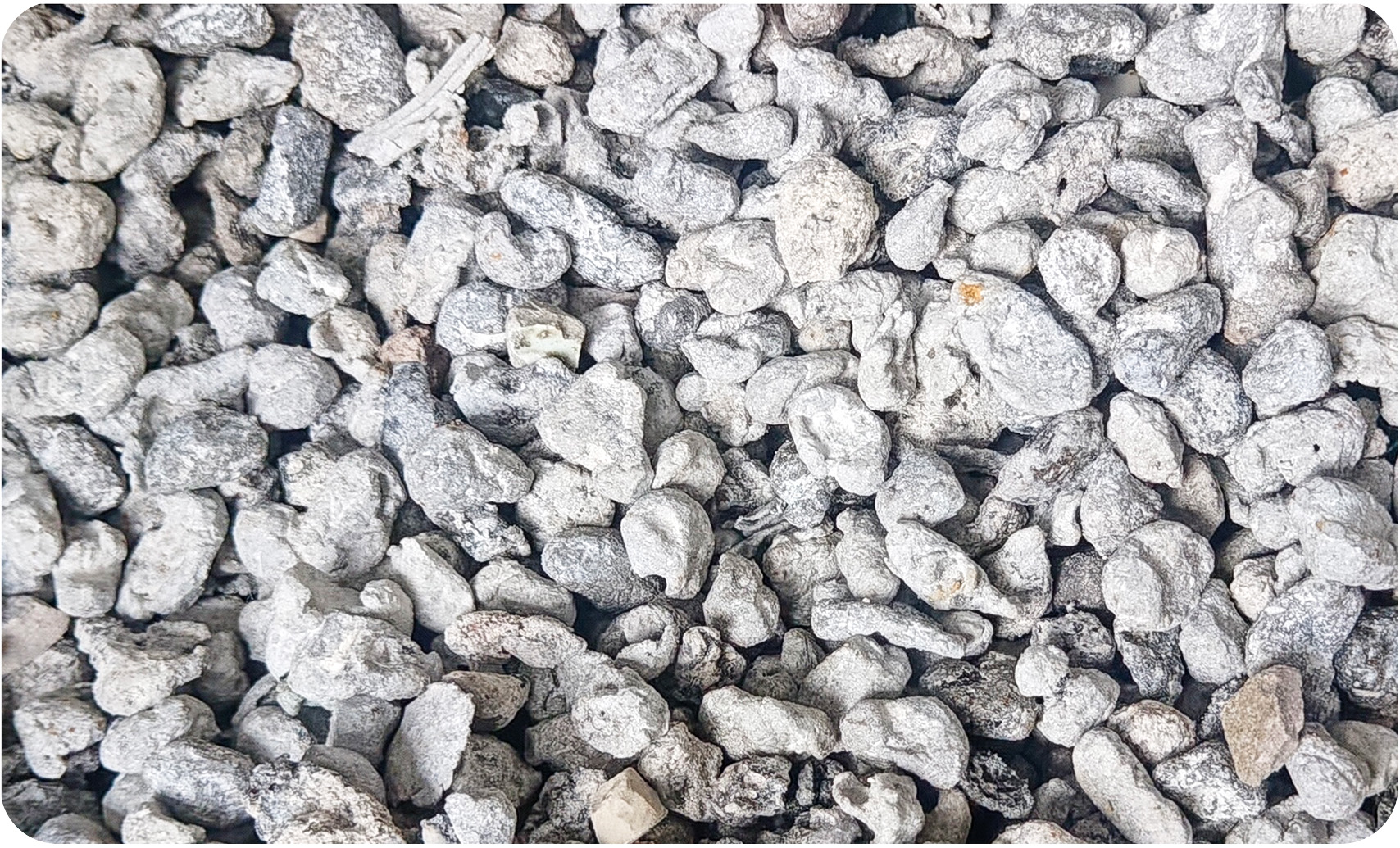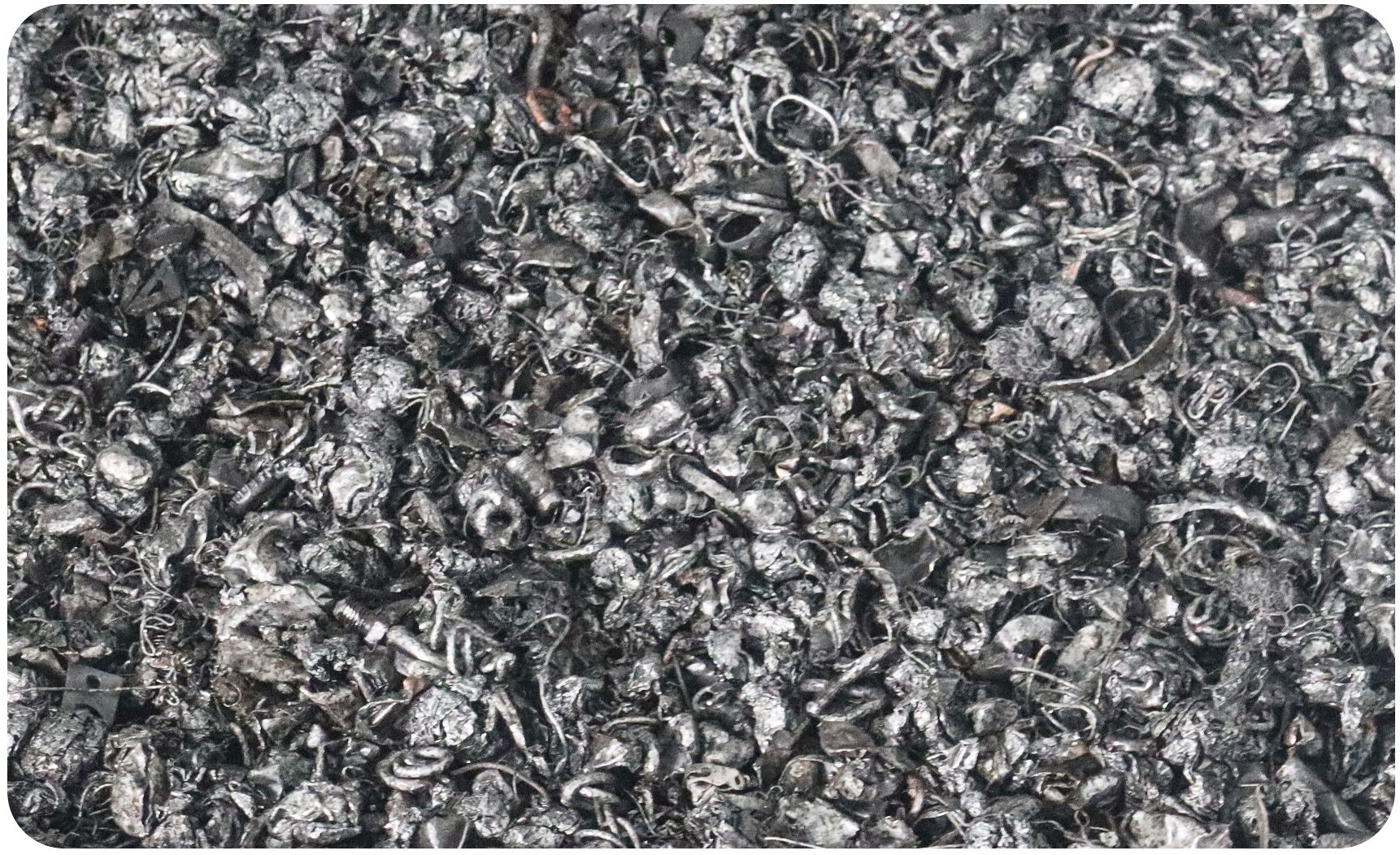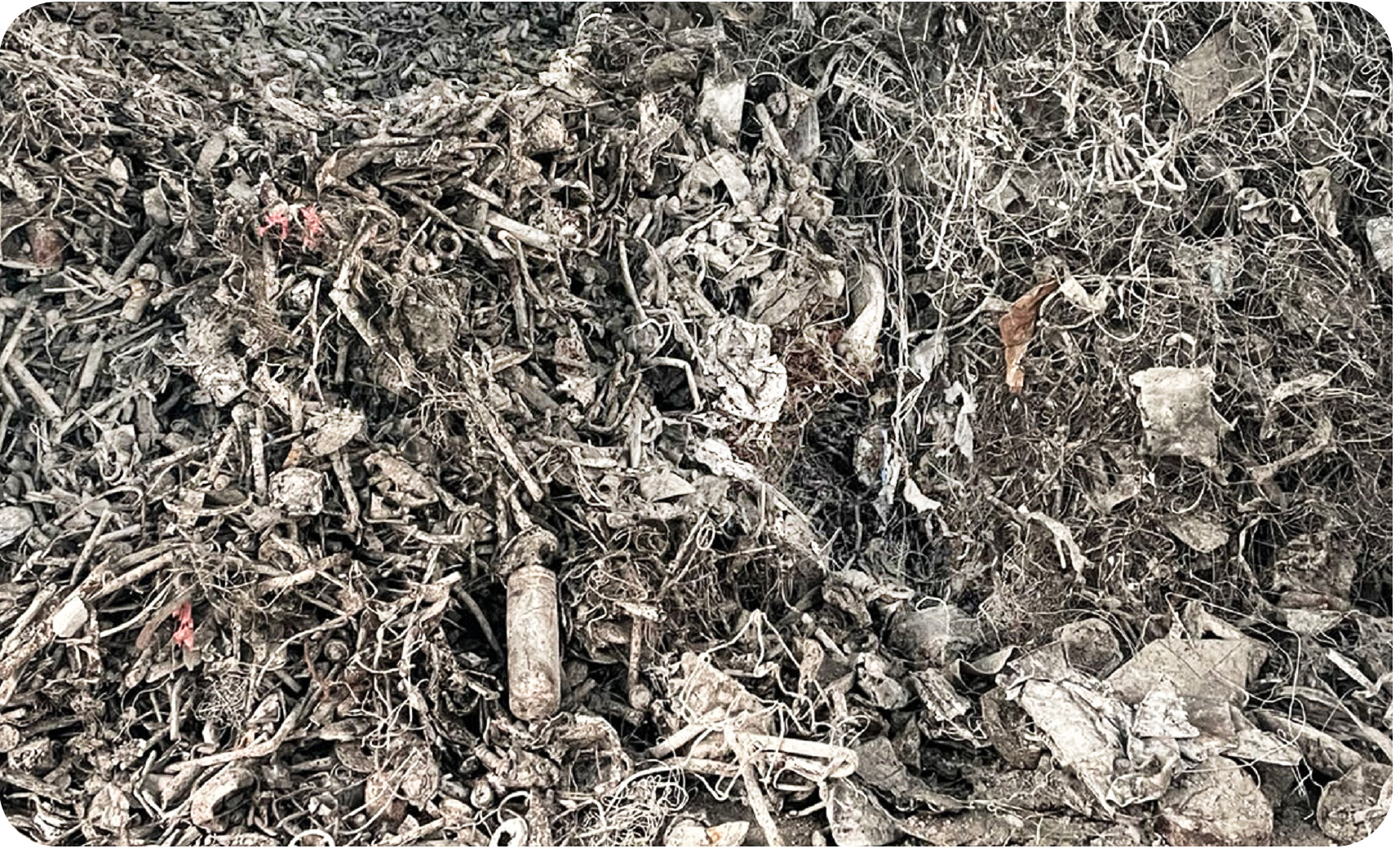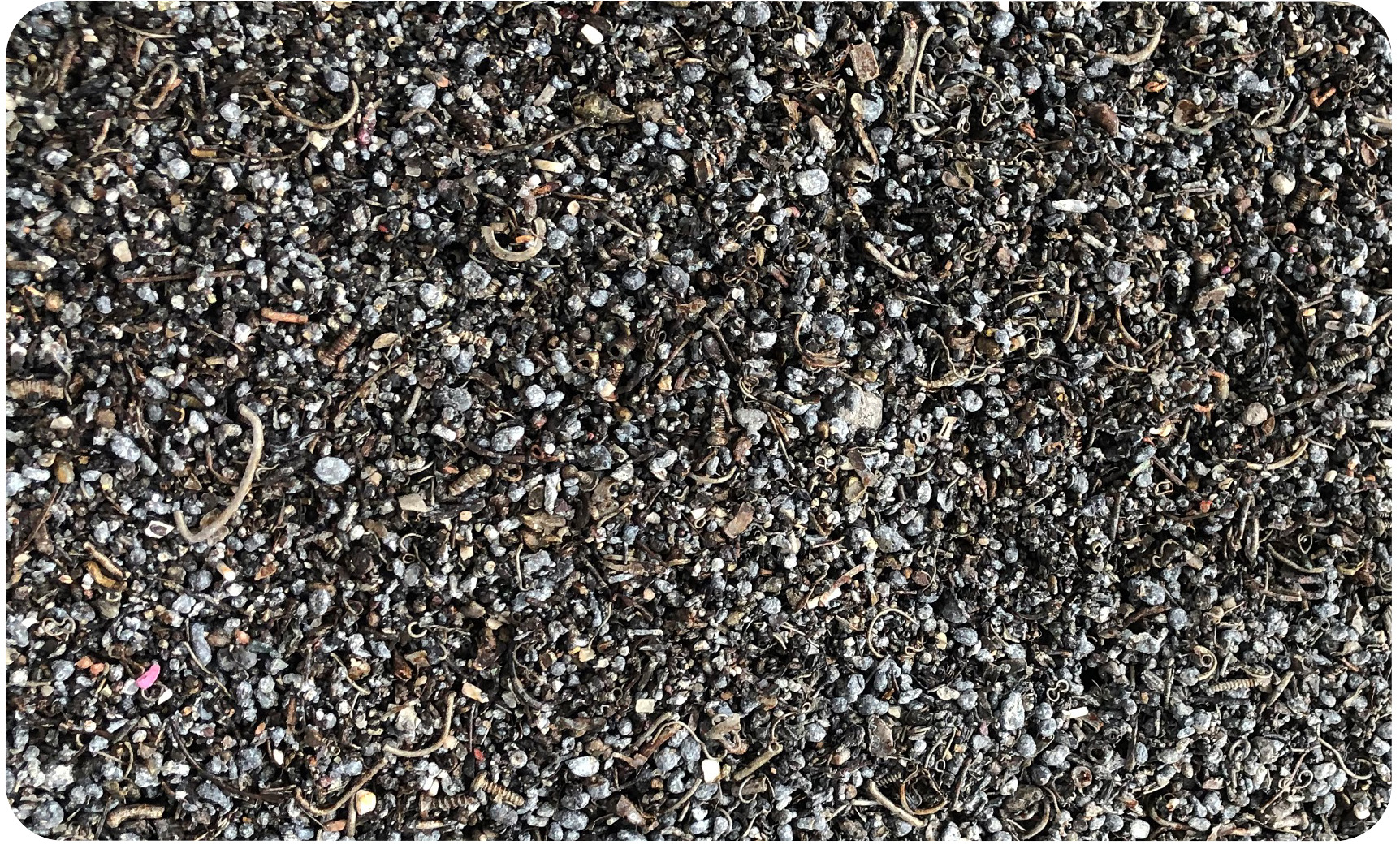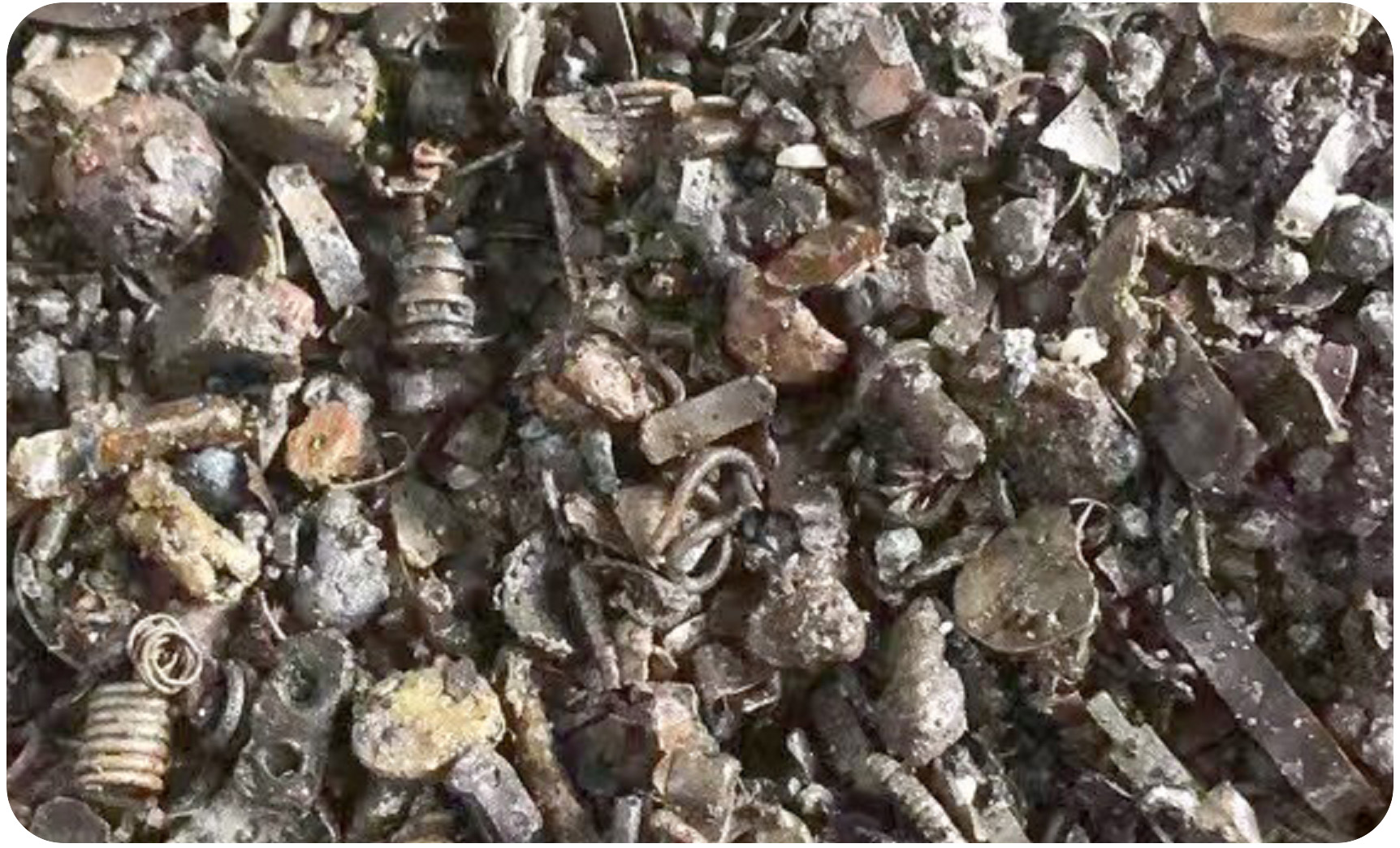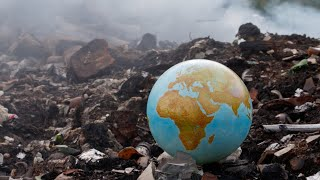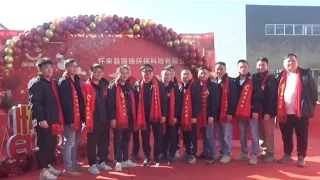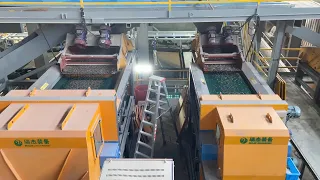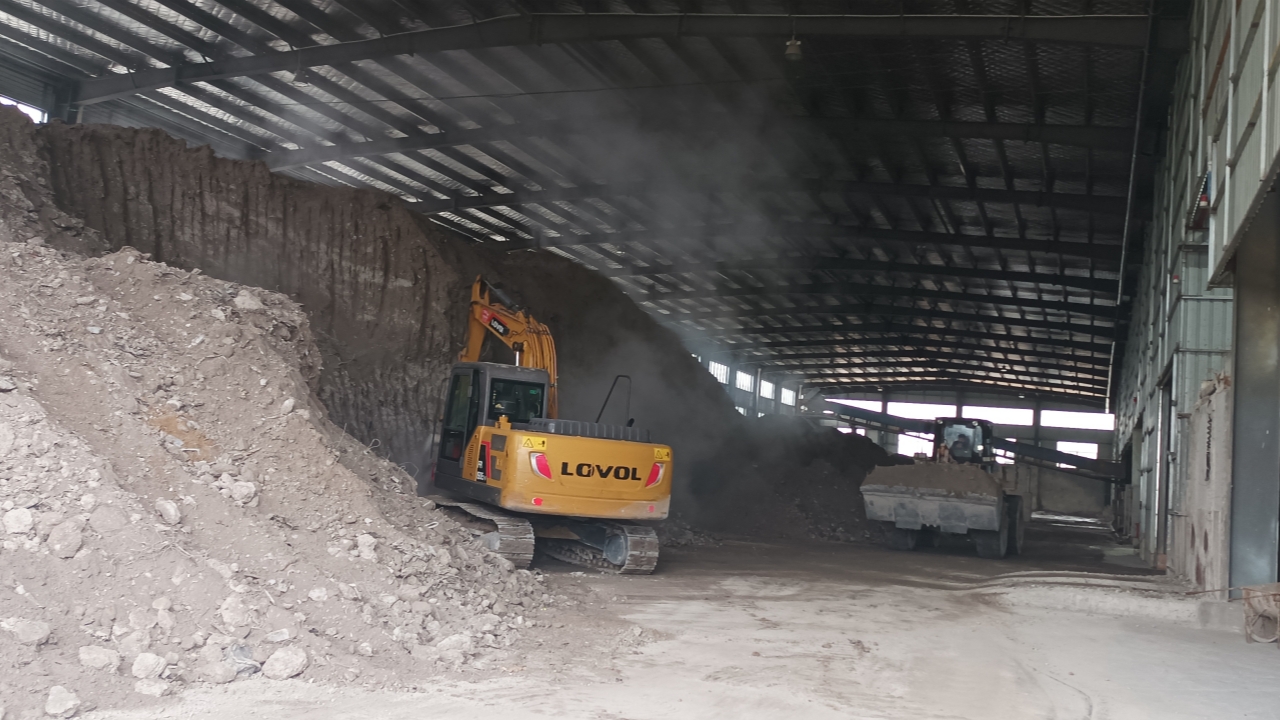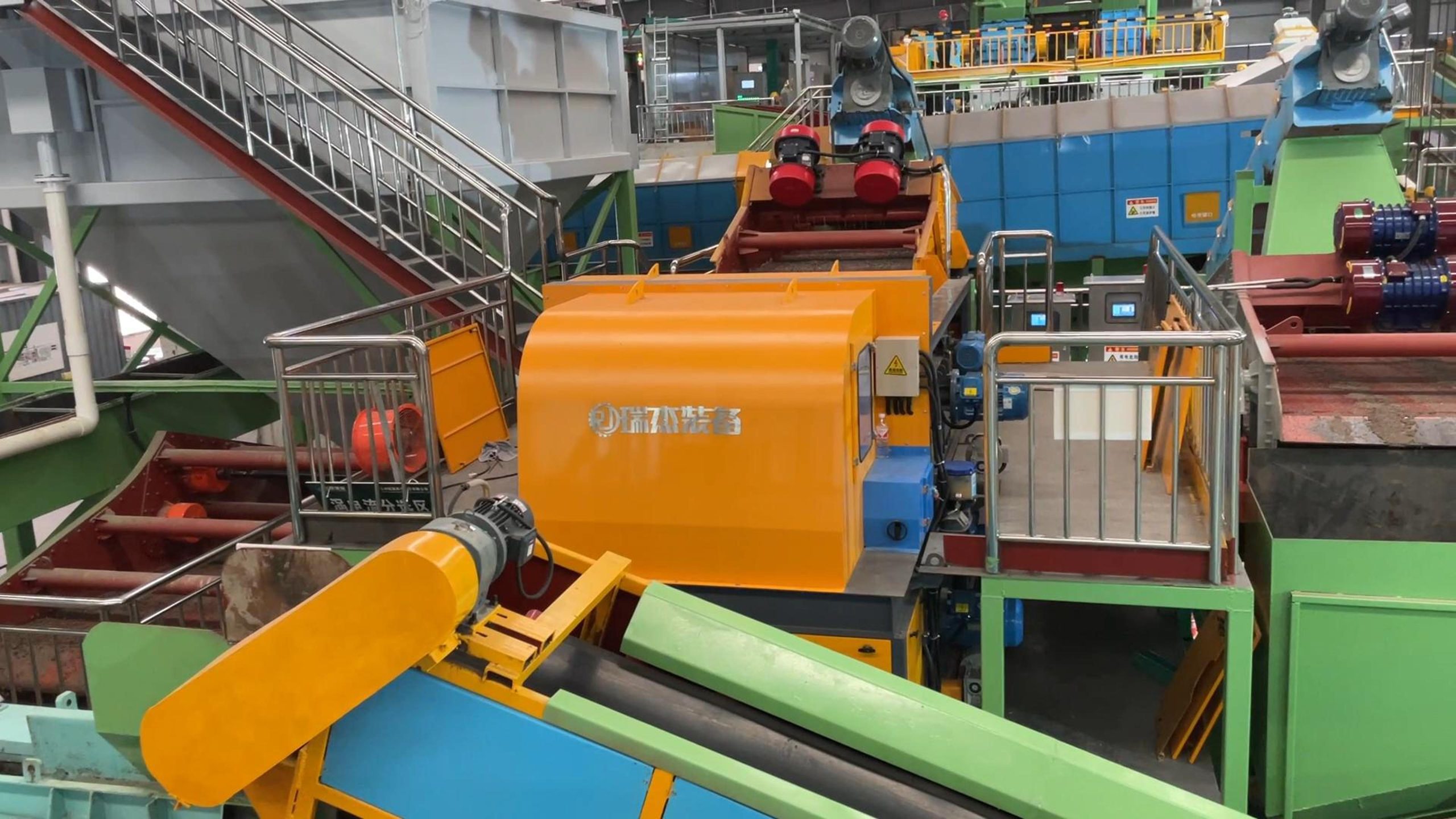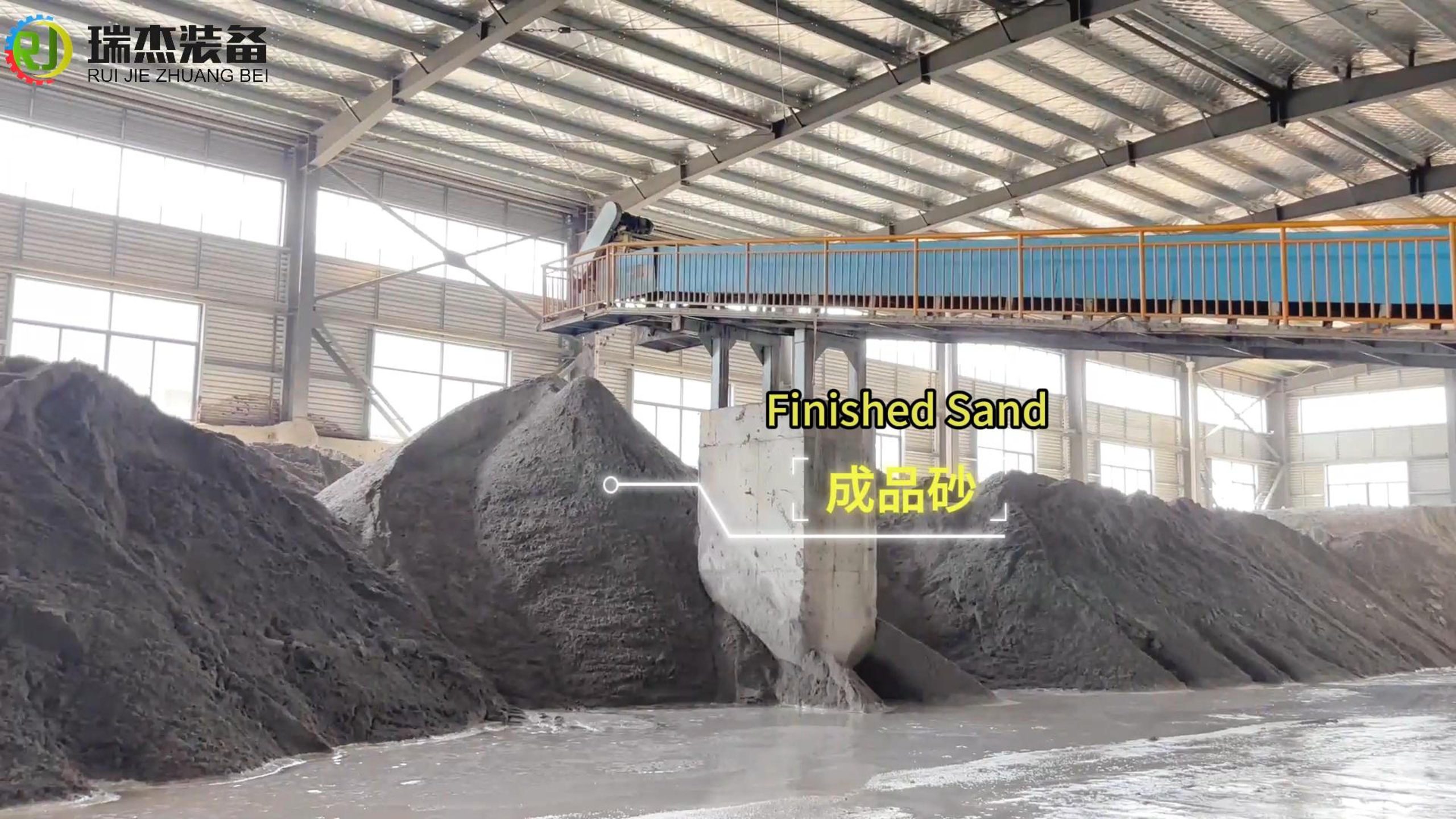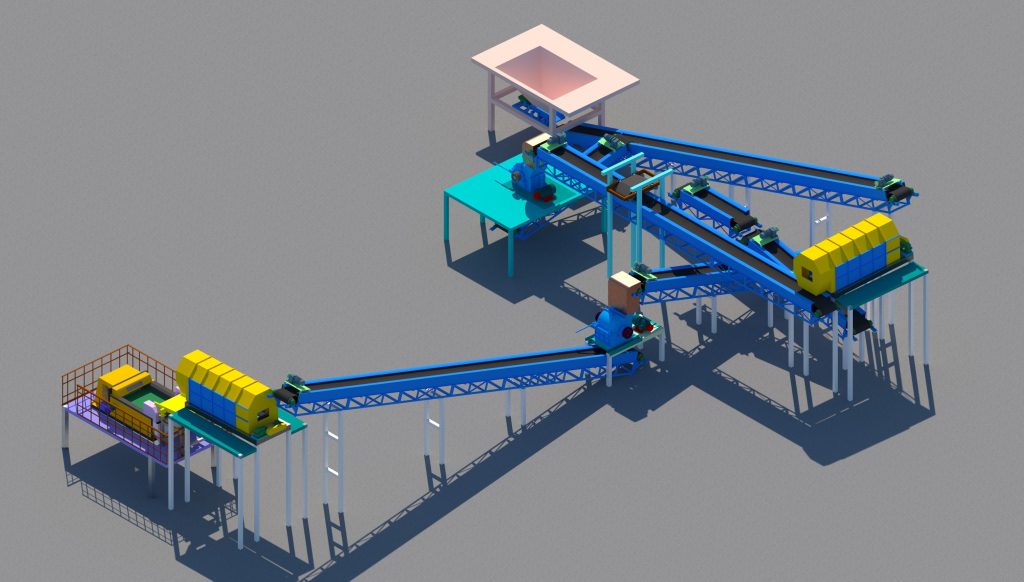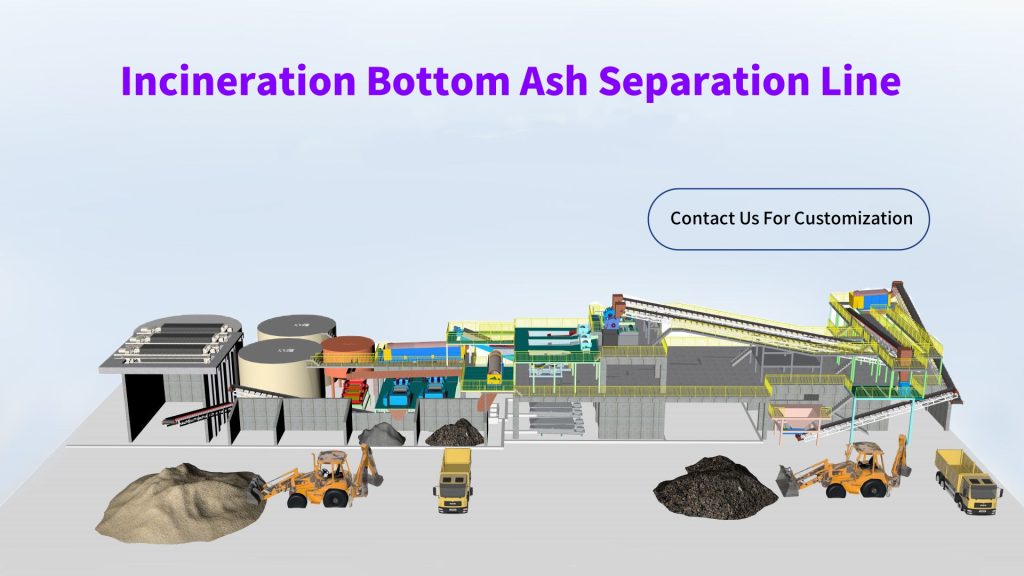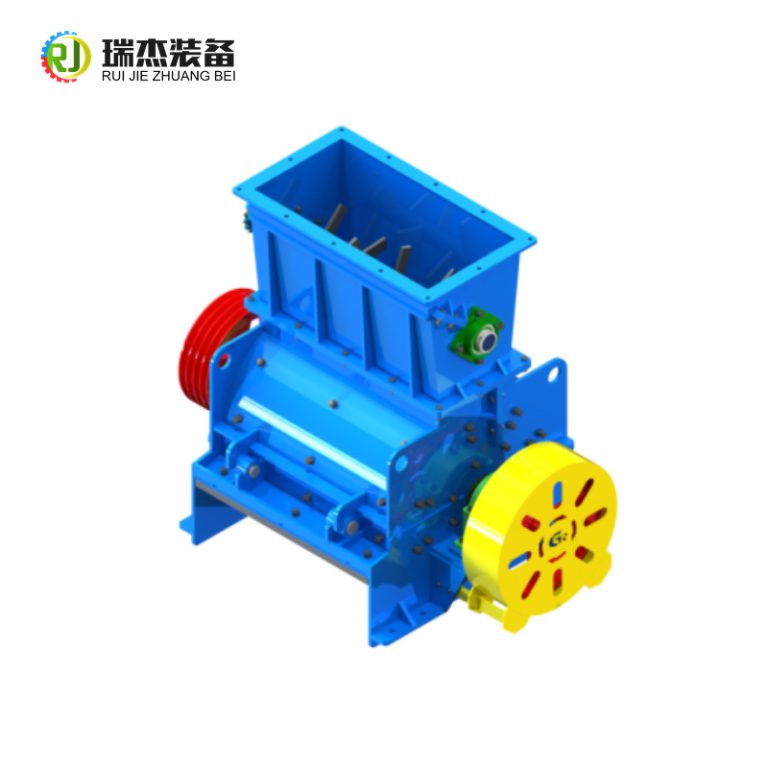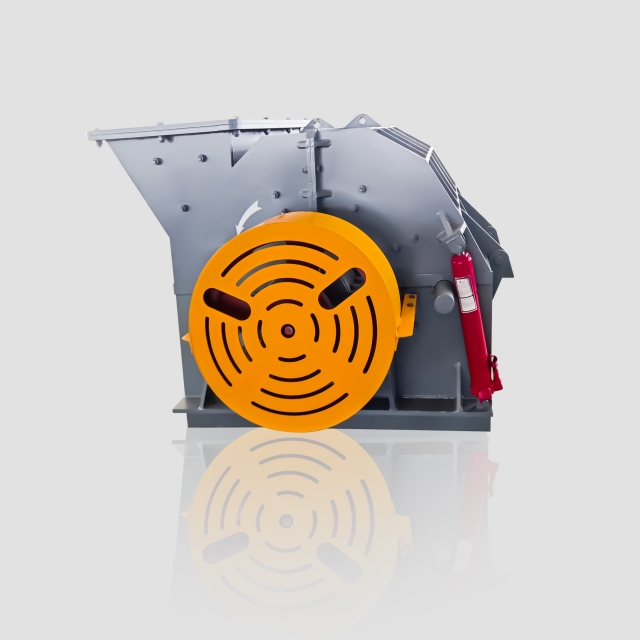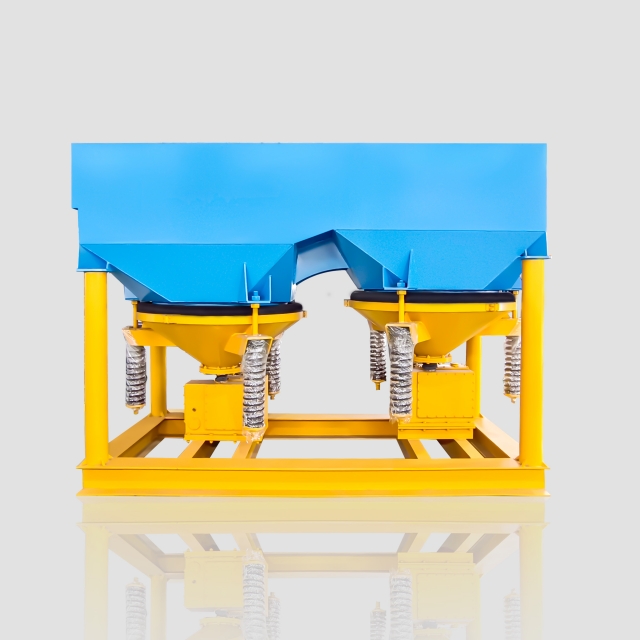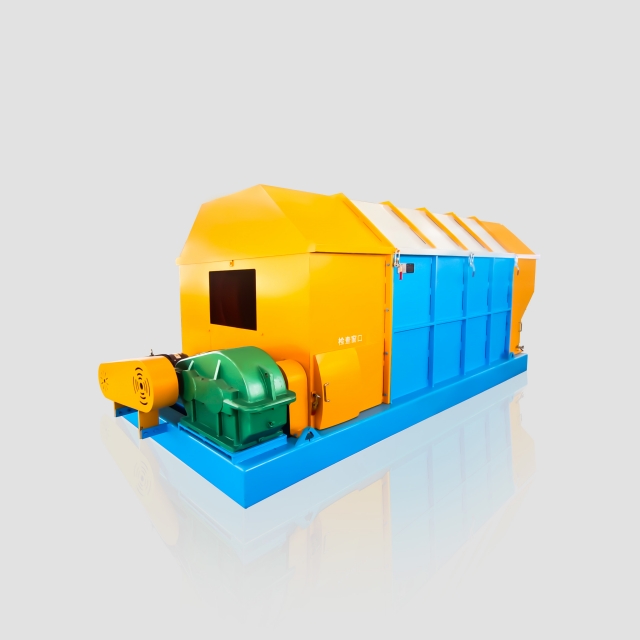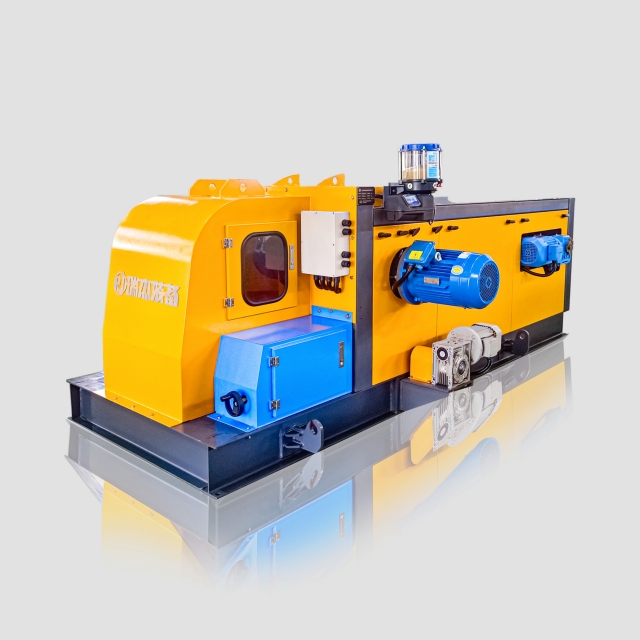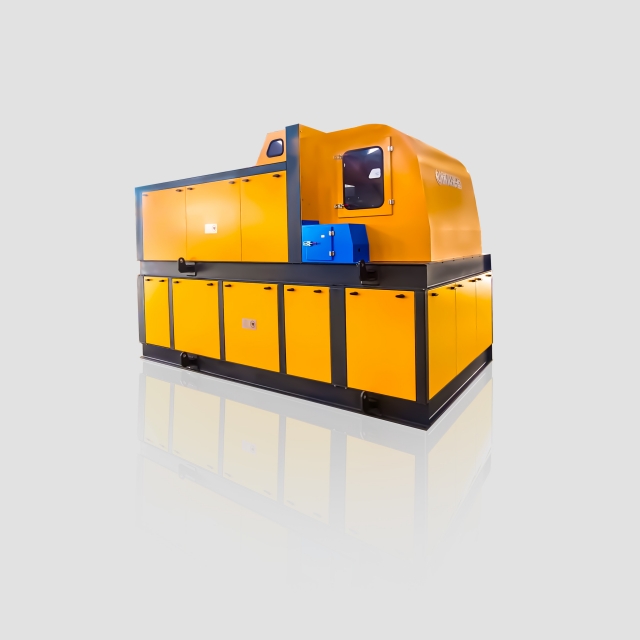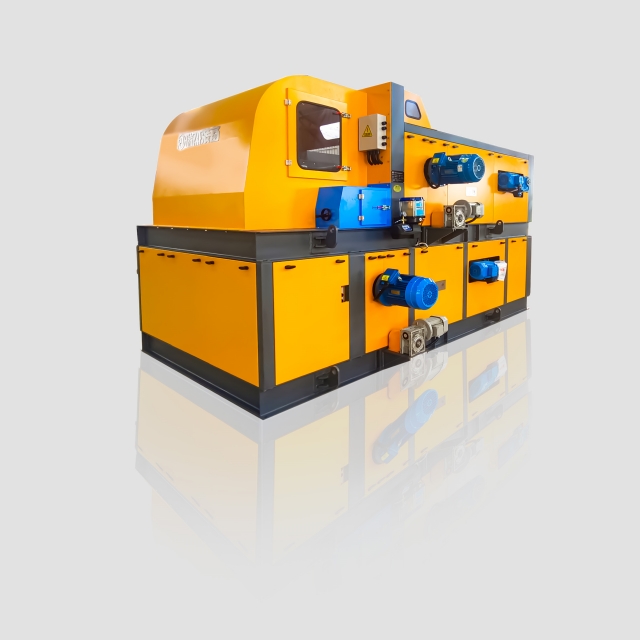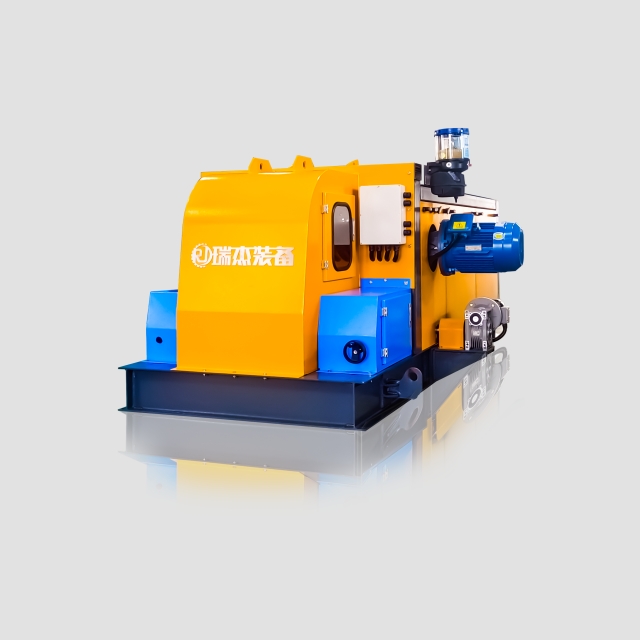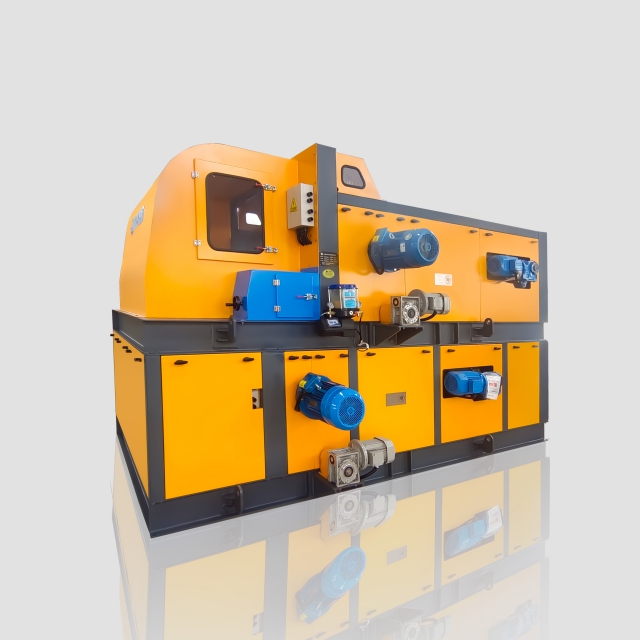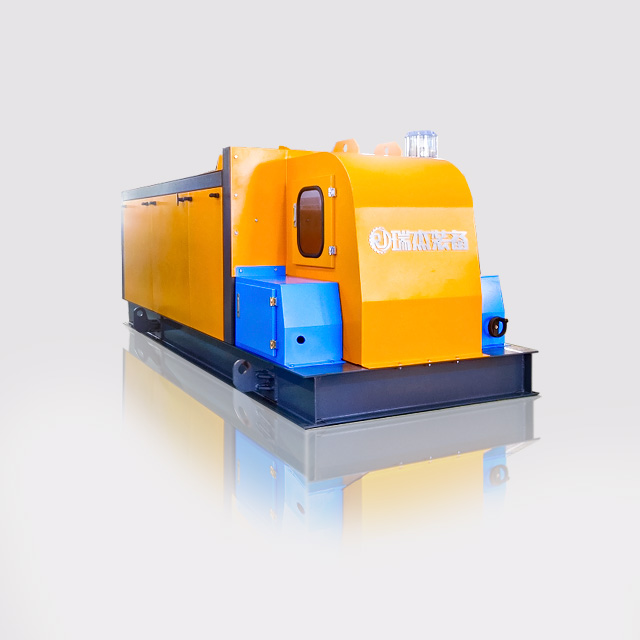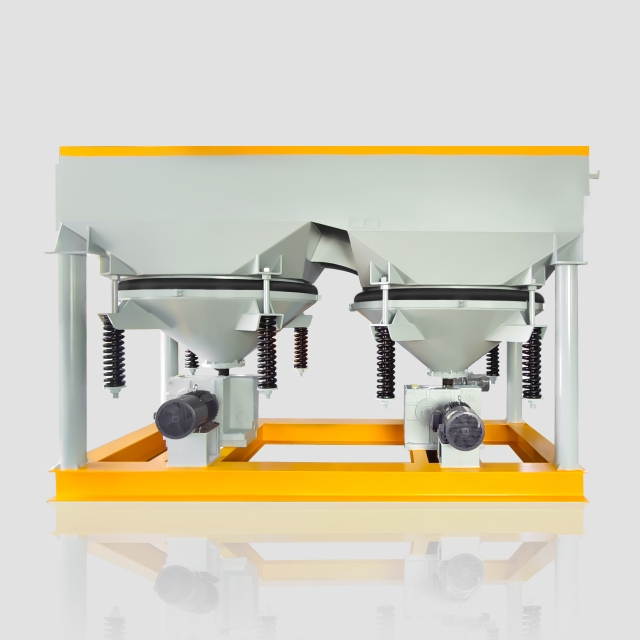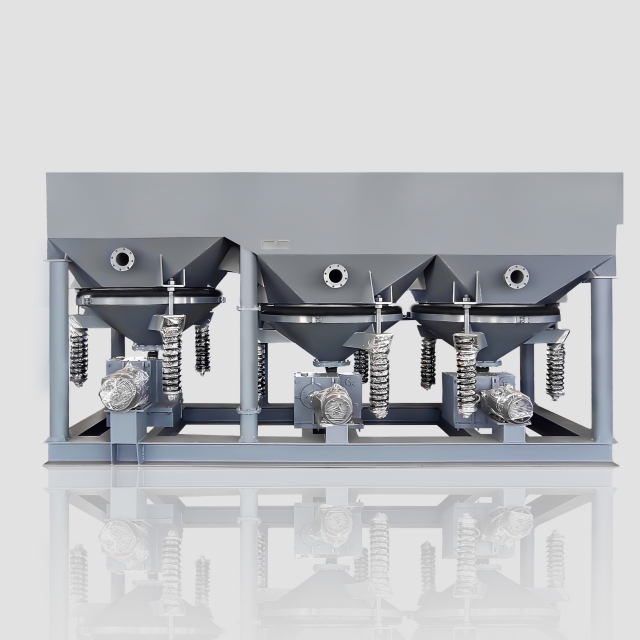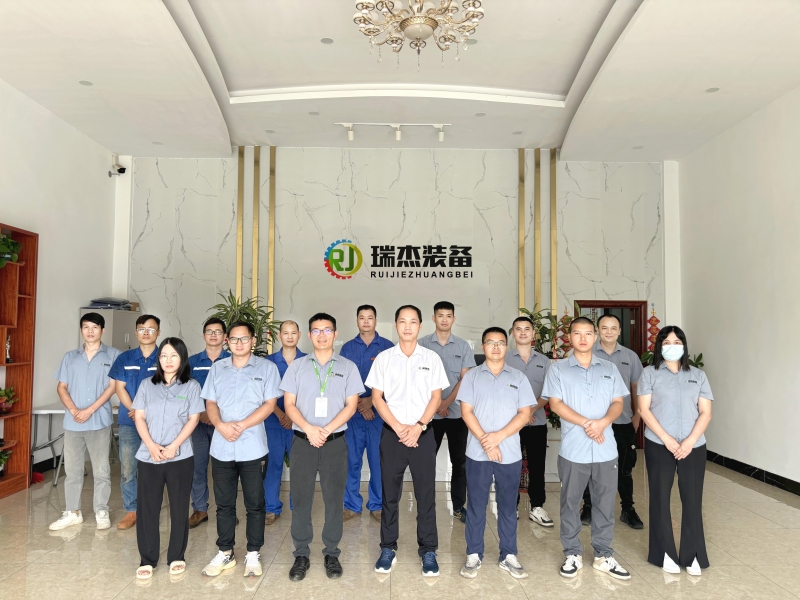Incineration Bottom Ash (IBA)
Wet Sorting Solution
RUIJIE-Incineration Bottom Ash (IBA) Recycling Equipment Manufacturer
Do You Know the Value of Incinerator Bottom Ash?
In the bottom ash (IBA) left over from the incineration process of waste-to-energy plants (EfW), there is a certain amount of precious metals such as gold and silver, copper, iron and other various metals.
These metal fragments are sought-after feedstocks for smelters and have an established supply chain to collect, process, and ultimately trade as commodities.
In the process of domestic waste incineration, the incineration plant produces about 0.23 tons of slag for every ton of domestic waste incinerated by the incineration plant. The slag produced after the domestic waste incineration power plant is solid waste. Its particle size is mainly distributed below 10 mm, mainly fine particles. The main components of IBA include slag, glass, ceramics, bricks, stones, etc., as well as plastics, metal substances (ferrous metals, non-ferrous metals, etc.), and organic substances such as paper, fibers, and wood that are not completely combusted.For this reason, IBA must be effectively separated before it can be used in a comprehensive manner.
IBA pretreatment can effectively separate and collect ferrous, non-ferrous, precious and heavy metals. They can be sold to metal recyclers. After optimization, the unburned surplus waste can be used in the sand and gravel aggregate building materials industry.Therefore, it is mainly used for pavement materials, cement or concrete substitute materials, landfill covering materials, etc.
RUIJIE Process Characteristics
1.No Air Pollution
Measures such as water injection crushing and sealing crushing are adopted to prevent dust from escaping and no air pollutant emissions.
2.No Waste Water Pollution
Through 100% recycling of the water recycling system, the purpose of no sewage discharge is achieved.
3.No Noise Pollution
The equipment with low noise and low vibration ensures that the noise emission of all kinds of equipment meets the limit standards during operation.
4.100% Utilization
The separated metal is recycled, and the slag is used to produce unburned brick products, which are 100% comprehensively utilized.
Incineration Bottom Ash (IBA) Sorting Equipment Core Technology
01.Slag Treatment Process: high recovery of scrap metal, clean production of environmentally friendly sand, containing less metal, glass, mud and impurities, and the whole production process is mechanically automatic. The new production line has the advantages of dustproof, noise reduction, sewage circulation filtration and utilization.
02.Crushing Series Products: new simple maintenance methods and waterproof treatment are added, which are more stable than traditional equipment, with finer output and larger processing capacity.
03.Jig Series Products: optimized cam transmission mechanism, higher metal recovery rate than traditional equipment, more energy-saving and durable.
04.Magnetic Separation Series Products: high remanence, high coercivity rare earth NdFeB magnetic block are as the bottom magnetic source, with low demagnetization rate, high separation purity.
05.Screening Series Products: compared with traditional screening equipment, the processing capacity is larger, the efficiency is higher, the screening accuracy is higher, and the operation is fully enclosed to avoid flying dust.
RUIJIEZHUANGBEI Process Flow
Our company mainly reprocesses the slag from the waste incineration power plant by physical methods (including particle size screening, magnetic separation, buoyancy separation and eddy current separation), separates out iron, metal aluminum and a small amount of non-magnetic metals (metal copper, etc.), and construction sand (coarse, medium, and fine sand) can be obtained at the same time. The sorted metal materials are sold to recycling units for reuse; Coarse, medium and fine sand materials are used in brick-making or reusing by building material production plants. The specific production process flow and pollution production process diagram are shown in the figure:
1.The preparation of environmentally friendly building materials
Environmental protection bricks (unburned bricks, colored road bricks, thermalinsulation materials) use slag as the main raw material. The slag is pretreated (weathered and metal removed), and materials such as cement, curing agent, activator (or pigment) are added in a certain proportion, and then pressed into shape.This process does not or autoclave. Its early strength is mainly formed by the pressure of the molding machine, and its later strength is mainly formed by the cement cementation and the exertion of slag activity. It is a mature process.
2.All Kinds of Precious Metals can be Recovered
The sorted aluminum metal is recycled by the material company.
The following aluminum is isolated from incineration bottom ash (IBA)
The sorted iron metal is recycled by the material company.
The following magnetic materials are separated from incineration bottom ash (IBA)
The sorted copper metal and various other non-ferrous metals are recycled by the relevant material companies.
The following copper metals are separated from incineration bottom ash (IBA)
Why So Much Customers Choose Us?
Ruijie Equipment has provided solutions and equipment for more than 200 slag recycling plants. This is due to our extensive experience in wet slag sorting.
1. We have a state-of-the-art water treatment system.The sewage can reach 100% recycling, meeting the environmental requirements of each country.
2. The characteristics of our slag disposal process are in the leading position among our peers.
3. It has rich industry experience and unique technical advantages.Our self-developed core technology is unique.
4. The slag and metal materials are separated, recycled and reused, with a recovery rate of up to 98%.
5. With a high-quality professional team and high-quality after-sales service, installation, training, factory construction, and so on one-stop service.
Thailand Incineration Bottom Ash(IBA) Project Machine Delivery
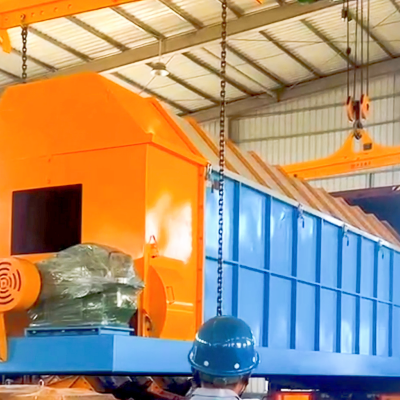
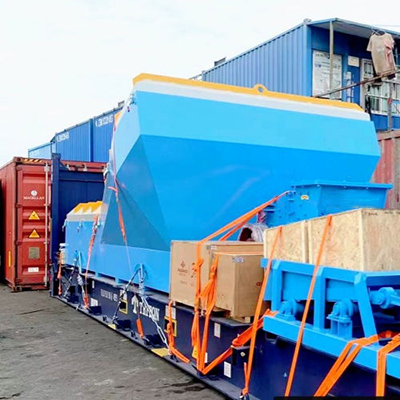
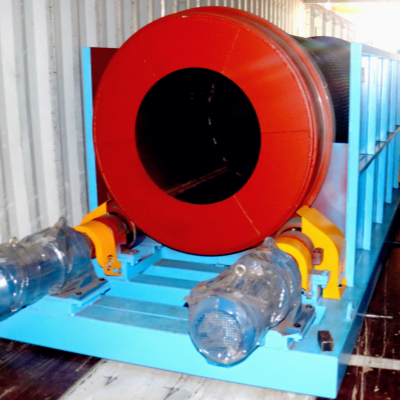
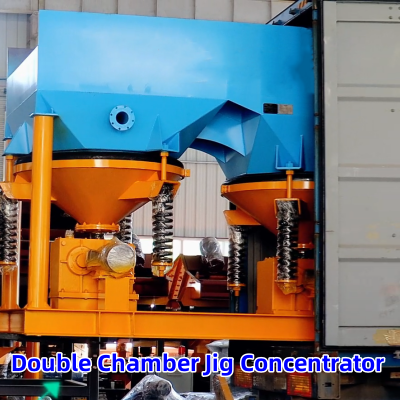
1.The Cost of Incineration Bottom Ash(IBA) Disposal
The incineration bottom ash treatment process requires capital investment, including equipment costs, labor costs, and waste disposal costs after treatment.This investment may be prohibitive for some producers, but the investment in treating slag is worth it in the long run. Because the profits recovered can often cover these costs and even bring significant profits to the business.
2.Profit From Incineration Bottom Ash(IBA) Disposal
The profit of incineration bottom ash treatment depends on how much of the residue can be recycled and the market price of these substances. For example, non-ferrous metals such as copper and aluminum can be recycled to create value. In addition, it can also be recycled by using slag as a material for building material production.In general, it is necessary for steel mills or other similar enterprises to dispose of slag. Investing in a treatment facility can be expensive, but in the long run, slag disposal is often very profitable.
Incineration Bottom Ash (IBA) Sorting Plant Project
The following are some examples of our projects.
IBA Sorting Plant Project
| Construction and Processing Scale of Slag Plan | 1000 tons/8 hours |
| Construction and Processing Scale of Slag Plan | 540 tons/8 hours |
| Construction and Processing Scale of Slag Plan | 600 tons/8 hours |
| Construction and Processing Scale of Slag Plan | 350 tons/8 hours |
| Construction and Processing Scale of Slag Plan | 650 tons/8 hours |
| Construction and Processing Scale of Slag Plan | 300 tons/8 hours |
3D Diagram Of Dry and Wet Sorting Line For Incineration Bottom Ash
The following drawings are for reference only, in addition, we can also customize the engineering scheme of dry separation line for incineration bottom ash and match the number of relevant magnetic separators according to the different processing capacity and other needs of customers
For technical assistance, expert advice and more information about IBA’s processing recycling systems, please do not hesitate to contact us.
FAQ
全球范围内垃圾焚烧发电厂的数量确实可能会增加。以下是支持这一趋势的一些主要因素:
1.环境法规及政策
- 严格的环保要求:越来越多的国家和地区加强了对垃圾处理的力度环保要求,推广垃圾发电作为减少填埋和垃圾处理成本的可行选择。
- 减排目标:为应对气候变化,减少温室气体排放,许多国家鼓励使用垃圾气体发电,可有效减少二氧化碳等温室气体的排放。
2.垃圾处理需求
- 城市化:随着全球城市化进程的加快,城市垃圾产生量日益增加,垃圾焚烧发电可有效处理大量城市垃圾,缓解填埋场压力。
- 废物管理:焚烧将废物转化为能源,减少对垃圾填埋场的依赖,这在资源稀缺、土地成本高的地区尤为重要。
3.技术进步
- 高效焚烧技术: 技术进步使得废物能源焚烧的效率和环境性能不断提高,包括改进的焚烧炉、气体清洁技术和热电联产系统。
- 自动化和智能化: 现代垃圾焚烧发电厂越来越依赖自动化和智能化技术来提高运营效率、降低运营成本并加强环境保护。
4.能源需求和可再生能源
- 能源需求增长:全球能源需求持续增长,垃圾焚烧发电提供了稳定、可再生的能源来源,可以有效满足部分能源需求。
- 能源多样化:作为可再生能源,垃圾焚烧发电可以帮助实现能源结构多样化,减少对化石燃料的依赖。
5.公众接受度和社会认知
- 增强环保意识:公众对废物管理和环境保护的意识不断增强,越来越多的人支持 将垃圾焚烧发电作为废物处理和能源生产的解决方案。
6.国际合作与融资
全球范围的技术交流与合作,有利于促进垃圾发电技术的开发和应用。
Many international organizations and financial institutions provide financial support to promote the implementation of waste-to-energy projects, especially in developing countries and emerging markets.
7.Government Incentives
Some countries and regions offer financial subsidies and incentives to encourage investment in waste-to-energy projects to promote the dual goals of waste treatment and energy production.
With the strengthening of environmental regulations, the advancement of technology, the growth of energy demand and the concern of society for environmental protection, waste-to-energy plants are expected to increase globally.
This trend will help improve the efficiency of waste disposal, reduce the need for landfills, reduce environmental impact, and provide a stable energy supply.
In terms of treating the separation of incineration bottom ash, some countries mainly use wet separation technology due to their strict environmental regulations and efficient resource recovery needs.
These countries often have advanced waste treatment facilities and strong environmental awareness.
Here are some of the countries where wet sorting technology is predominantly adopted:
1.Germany
Germany is a global leader in environmental protection and waste management. The Germany government has strict regulations on waste disposal, requiring reduced pollution and higher resource recovery rates.
Incineration bottom ash treatment plants in Germany use wet sorting technology to reduce dust emissions and increase metal recovery. Wet sorting technology helps to process fine particles in bottom ash and meets strict environmental standards.
2.Sweden
Sweden is committed to efficient waste management and resource recovery. The country’s environmental regulations require the reduction of the environmental impact of waste.
Incineration bottom ash treatment facilities in Sweden make extensive use of wet sorting technology to reduce dust generation and improve recovery efficiency. These facilities comply with environmental regulations by wet sorting of metals and other valuable substances in the bottom ash.
3.Netherlands
Netherlands has strict regulations and practices in waste management and is committed to promoting resource recycling and reducing environmental impact.
Some incineration bottom ash treatment plants in Netherlands use wet sorting technology, mainly to reduce dust emissions and increase metal recovery. Wet sorting helps to treat the more adhesive bottom ash and improves the separation effect.
4.Norway
Norway has very strict regulations on waste management and environmental protection, and the country is committed to reducing the environmental impact of waste.
Incineration bottom ash treatment plants in Norway use wet sorting technology for more efficient sorting and dust control. Wet separation technology is used in these facilities to treat fine particles and adherent substances in the bottom ash
5.Canada
Canada also has high environmental requirements, especially in waste disposal and resource recovery.
In some incineration bottom ash treatment facilities in Canada, wet sorting technology is used to improve metal recovery and reduce dust emissions, in line with environmental standards.
6.Switzerland
Switzerland has high requirements for environmental protection and waste management, and has implemented many strict environmental policies.
Incineration bottom ash treatment facilities in Switzerland use wet sorting technology to reduce dust emissions and increase resource recovery. This helps to comply with Switzerland’s environmental regulations and increases recycling efficiency.
7.Austria
Austria is committed to environmental protection and resource recycling and has implemented strict waste disposal regulations.
Some incineration bottom ash treatment plants in Austria use wet sorting technology, especially in the treatment of adherent substances and fine particles in the bottom ash, in order to meet environmental requirements.
8.Finland
Finland attaches great importance to environmental protection and resource management and follows strict environmental standards.
Incineration bottom ash treatment facilities in Finland use wet sorting technology to increase metal recovery and reduce dust. Wet separation helps to deal with fine particles and adherent substances in the bottom ash.
9.Singapore
Faced with a high population density and limited land resources, Singapore has high standards for waste disposal.
Some incineration bottom ash treatment plants in Singapore use wet sorting technology to reduce environmental pollution and increase recovery rates. Wet separation technology helps to deal with adherent substances and fine particles in the bottom ash.
10.Japan
Japan has strict regulations on waste management and resource recycling, and is committed to reducing the environmental impact of waste.
In some incineration bottom ash treatment facilities in Japan, wet sorting technology is used to improve metal recovery and reduce dust emissions. Wet sorting technology helps to deal with complex bottom ash and improve treatment results.
11. Australia
Australia is committed to improving waste management efficiency and resource recovery, and the government has strict regulations on waste disposal.
Some incineration bottom ash treatment plants in Australia use wet sorting technology, especially for the treatment of fine particles and improved recovery efficiency.
12. Ireland
Ireland values environmental protection and resource recycling and is committed to reducing the environmental impact of waste.
Some incineration bottom ash treatment facilities in Ireland use wet sorting technology to meet environmental regulations and improve sorting results.
13. Brazil
In recent years, Brazil has begun to pay attention to waste management and environmental protection, and has gradually introduced advanced treatment technologies.
In some incineration bottom ash treatment facilities in Brazil, wet sorting technology is used to improve sorting efficiency and reduce dust emissions.
14. Portugal
Portugal has gradually strengthened environmental protection measures in waste management and resource recovery, striving to improve the efficiency of resource recovery.
Some incineration bottom ash treatment plants in Portugal use wet sorting technology to reduce dust emissions and increase metal recovery.
15. Russia
Russia is gradually introducing advanced technologies in waste management, focusing on environmental protection and resource recovery.
Some incineration bottom ash treatment facilities in Russia have begun to use wet sorting technology, especially for the treatment of fine particles and adherent substances in bottom ash.
16.Thailand
Thailand is gradually introducing advanced technologies in environmental protection and waste treatment.
Some incineration bottom ash treatment facilities in Thailand have begun to apply RUIJIE Wet Sorting Technology to improve treatment effectiveness and recovery efficiency.
These countries and regions have chosen wet sorting technology because of its ability to reduce dust emissions, improve resource recovery, and meet stringent environmental standards.
The advantages of wet separation technology are the processing of highly adhesive bottom ash and fine particles, improving the accuracy and efficiency of sorting, and meeting the high requirements of these countries in terms of waste treatment and environmental protection.
The outlook for the future of incineration ash is generally positive, driven by several factors:
1.Promotion Of Environmental Regulations
- Stringent Regulations: Globally, environmental regulations and standards are becoming more stringent, driving advances in incineration bottom ash treatment technology. Regulations require companies to reduce waste to landfills and reduce harmful emissions, thereby promoting improvements in bottom ash treatment technology.
- Emission Reduction Targets: Many countries have set targets for waste reduction and landfilling, which has led to the need for reciprocal ash treatment.
2.Technological Advancements
- Resource Recovery Technology: Technological progress has led to an increase in the resource recovery rate of incineration bottom ash. For example, advanced sorting technologies (e.g., wet separation, magnetic separation) are able to effectively recover metals and other valuable substances from bottom ash.
- Intelligence and Automation: The application of intelligent control system and automation technology makes the incineration bottom ash treatment process more efficient and accurate, and improves the treatment effect.
3.Resource Utilization
- Economic Value: The metal, glass, ceramics and other components in the incineration bottom ash have certain economic value. Through technological innovation, the bottom ash can be converted into building materials, concrete, etc., to improve its resource utilization.
- Green Development: The global focus on resource recycling and green development will promote the resource utilization of bottom ash and reduce the dependence on landfills.
4.Social and Economic Factors
- Public Awareness: Rising public awareness of environmental protection will encourage governments and enterprises to adopt more advanced incineration ash treatment technologies.
- Economic Incentives: With the maturity of resource recovery technology and the growth of market demand, the economic return on investment in incineration bottom ash treatment technology will gradually emerge.
The future prospects for incineration ash are positive. With the stricter environmental protection regulations, the acceleration of technological progress, the promotion of resource utilization and the enhancement of international cooperation, the treatment and utilization of incineration bottom ash will become more efficient and environmentally friendly.
This will help achieve higher resource recovery rates, reduce environmental impact, and promote sustainable waste management and resource recovery.
In the future, the development trend of incineration bottom ash treatment will focus on efficient resource recovery, strict environmental protection regulations, intelligence and automation, international cooperation and standardization, etc., to promote the comprehensive upgrading of waste management and resource utilization.
With the continuous advancement of technology and the stricter regulations, the treatment of incineration bottom ash will become more environmentally friendly and efficient
In foreign countries, there are both wet and dry separation. This depends on the specific treatment needs, the characteristics of the bottom ash, the maturity of the technology, and the environmental requirements. Here are some examples of the international applications of wet and dry separation:
Wet Sorting
Situation Of Application
- Areas With Strict Environmental Protection Requirements: For example, in some countries in Europe, due to strict environmental regulations, wet sorting is widely used to reduce dust emissions and improve the working environment. For example, incineration bottom ash sorting plants in countries such as Germany, Sweden and the Netherlands use wet sorting technology, which reduces dust pollution and improves sorting accuracy.
- Handling Viscous Bottom Ash: Wet sorting is particularly effective for handling viscous bottom ash or bottom ash containing fine particles. Sorting plants in these regions may use wet sorting to treat adherent substances in the bottom ash to improve metal recovery.
Advantage
- Dust Reduction: Reduces dust in the air and meets strict environmental standards.
- Improved Recovery: Enables more efficient separation of fine particles, improving the recovery of metals and other valuable substances.
Dry Sorting
Situation Of Application
- Economic Considerations: Incineration bottom ash separators in some countries may prefer to use dry separation technology due to its relatively low initial investment and maintenance costs. For example, some plants in the United States and some Asian countries use dry sorting technology.
Overall, wet and dry sorting have their own advantages and scenarios. The choice of technology usually depends on the characteristics of the bottom ash, environmental requirements, cost budget and technical conditions.
Many modern incineration bottom ash separation plants may employ wet sorting technology on a case-by-case basis to optimize treatment and economic benefits.
The construction and operating costs of an incineration bottom ash separation plant are influenced by a variety of factors, including plant size, sorting technology, equipment configuration, location, and local environmental regulations
Here are some of the main cost components and considerations:
Construction Costs
1.Plant Construction:
- Construction Costs: include the construction costs of factories and storage facilities, involving foundation works, building materials and construction costs.
- Environmental Facilities: including the cost of construction of wastewater treatment and noise control facilities.
2.Equipment Investment
- Sorting Equipment: including the purchase and installation costs of magnetic separators, gravity sorting equipment, vibrating screens, crushers and other equipment.
- Ancillary Equipment: such as conveyor belts, hoists, wastewater treatment equipment, etc.
3.Technical and Design Costs:
- Engineering Design: including process design, equipment selection, process optimization and other costs.
4.Licensing and Compliance Fees:
- Environmental Permit: The cost of obtaining an environmental protection and construction permit.
- Regulatory Compliance: The cost of complying with local environmental regulations and standards.
Operating Costs
1.Energy Cost:
- Electricity: The cost of electricity required to operate sorting equipment and other facilities.
2.Raw Materials & Consumables:
- Consumables: such as filters, replacement equipment parts, etc.
3.Staff Salary:
- Operating Personnel: The salaries of the people who operate the plant.
- Management: Salaries of management and technical staff.
- Administrative Staff:Salaries of management and technical staff.
4.Maintenance & Repair:
- Equipment Maintenance: The cost of regular maintenance and repair of equipment.
- Maintenance Materials: such as lubricating oil, detergent, etc.
5.Insurance:
- Property Insurance: The cost of insuring plant, equipment and inventory.
- Environmental Liability Insurance: Insurance that covers risks related to environmental protection.
6.Cost Estimates:
- Construction Costs: For a medium-sized incineration bottom ash separation plant, the construction cost can range from millions to tens of millions of dollars, depending on the specific equipment configuration, plant size and technical requirements.
- Operational Costs: Operating costs typically account for a large percentage of total annual costs and can range from a few million to tens of millions of dollars. The exact amount depends on the price of energy, labor costs, raw material costs, and maintenance needs.
Understanding specific construction and operating costs requires detailed engineering and budgeting, adjusted to local realities. If you need an accurate cost estimate, you can contact RUIJIE Equipment Supplier for detailed cost analysis and quotation.
The environmental protection measures of the incineration bottom ash separation plant include a number of aspects aimed at reducing the environmental impact and ensuring compliance with relevant environmental regulations. Here are some of the key environmental measures:
1.Wastewater Management:
- Wastewater Treatment: Treat the wastewater generated in the treatment process, use sedimentation tanks, filter presses or chemical devices to remove harmful substances and ensure that the wastewater meets the discharge standards.
- Cyclic Utilization: Recovering and recycling water from treatment processes, reducing the use of new water and the discharge of wastewater.
2.Bottom Ash Stabilization and Curing:
- Stabilization Treatment: By adding curing agents and stabilizing materials, heavy metals and harmful substances in the bottom ash are treated to reduce the dissolution of the bottom ash and environmental risks.
- Curing Technology: The curing technology is used to transform the treated bottom ash into a stable solid form, reducing the impact on the environment.
3.Noise Control:
- Noise Protection: Install sound insulation and noise control equipment, such as sound walls and low noise equipment, to reduce the impact of noise generated during the sorting process on the surrounding environment.
- Regular Maintenance: Perform regular maintenance on the equipment to ensure its normal operation and reduce noise generation.
4.Waste Management:
- Classified Treatment: Separate the waste generated in the sorting process to ensure that hazardous waste and non-hazardous waste are disposed of or recycled separately.
5.Environmental Monitoring:
- Environmental Testing: Conduct regular environmental monitoring, including testing of exhaust gas, wastewater, soil, and bottom ash, to ensure that the separation plant is operating in accordance with environmental standards.
- Data Recording: Record monitoring data, analyze and evaluate the effectiveness of environmental protection measures, and adjust and improve them in a timely manner.
6.Regulatory Compliance:
- Compliance Management: Ensure that the operations and emissions of the sorting plant comply with national and local environmental regulations and standards, and regularly review and update compliance measures.
Through these environmental protection measures, the incineration bottom ash separation plant can greatly and effectively control and reduce the negative impact on the environment, protect the quality of air, water and soil, and promote sustainable development.
Improving the metal recovery rate of an incineration bottom ash separation plant involves optimizing the sorting technology and process, which can be achieved through the following aspects:
1.Optimize Sorting Technology:
- Advanced Magnetic Separation Equipment: The use of high-efficiency RUIJIE Magnetic Separators, such as high-strength magnetic rollers and magnetic rods, can effectively separate ferromagnetic metals (such as iron and steel) and improve the recovery rate.
- Gravity Separation Technology: Efficient gravity separation equipment (such as permanent magnetic separator, spiral sand washers, jig machine sorting) is used to separate metals of different densities, especially non-ferrous metals (such as aluminum, copper, zinc).
- Advanced Vibrating Screen: The use of high-frequency vibrating screens to improve the accuracy of sorting bottom ash with different particle sizes, ensuring more effective separation of metals.
2.Improve The Pretreatment Process:
- Crushing and Screening: The bottom ash is refined to reduce the particle size and improve the separation efficiency of metals from other substances.
3.Improving The Performance Of Your Sorting Equipment:
- Equipment Maintenance and Calibration: Regularly maintain and calibrate the sorting equipment to ensure its work efficiency and sorting accuracy.
- Equipment Upgrades: Introduce the latest technology and equipment with efficient sorting and recycling equipment to improve overall processing capacity and metal recovery.
4.Optimize The Process Flow:
- Multistage Separation: Multi-stage separation processes such as primary magnetic separation, gravity separation and fine magnetic separation are used in the separation process to gradually increase metal recovery.
- Integration Of Sorting Processes: Integrating different types of sorting technologies and processes into one efficient process ensures that all stages work together to improve the overall recovery results.
5.Data Monitoring and Optimization:
- Real-time Monitoring: Install sensors and RUIJIE incineration bottom ash monitoring system to monitor key parameters in the sorting process in real time, such as flow rate, equipment usage, etc., to adjust and optimize the process in time.
- Data Analysis: Optimize operating parameters and process settings to improve metal recovery through data analysis.
6.Training Operators:
- Operational Training: Operators are trained to ensure that they are familiar with the operation and maintenance of sorting equipment, and to improve operational skills and efficiency.
Through these measures, the incineration bottom ash separation plant can effectively improve the metal recovery rate, achieve more efficient resource recovery and utilization, and reduce the environmental impact of the bottom ash.
The main functions of the incineration bottom ash separation plant include:
1.Metal Recycling:
- Separation Of Metals: from the incineration bottom ash to separate valuable metals, such as iron, aluminum, copper, zinc, etc. These metals can be recycled and reused, reducing waste.
- Increase Recovery Rate: Improve the recovery efficiency and purity of metals by optimizing the separation technology.
2.Bottom Ash Treatment:
- Reduced Volume: Through sorting and treatment, the volume of incineration bottom ash is reduced, thus reducing the difficulty of storage and disposal.
- Improve Safety: Remove harmful substances and heavy metals from the bottom ash to reduce the risk of the bottom ash to the environment and human health.
3.Waste Disposal:
- Resource Utilization: The treated bottom ash is converted into utilizable resources, such as building materials, filling materials, etc., to reduce the dependence on landfill.
- By-product Management: By-products produced during the treatment process can be further treated or recycled.
4.Environmental Compliance:
- Pollution Control: Ensure that exhaust gas, dust and wastewater discharges during the sorting process comply with environmental regulations and reduce negative impacts on the environment.
- Quality Control: Ensure that the treated bottom ash quality meets the relevant environmental standards to reduce pollution to soil and water.
The main role of the incineration bottom ash separation plant is to recover valuable metal resources, reduce the volume and danger of bottom ash through efficient sorting and treatment, and at the same time meet environmental protection standards to promote the resource utilization and safe disposal of bottom ash.
Ensuring the safe operation of an incineration bottom ash separation plant is critical, and it involves a number of aspects of safety management and control. Here are some of the key measures:
1.Establish ASafety Management System
- Safety Policies and Procedures: Develop and implement comprehensive safety management policies and operating procedures, including safety operating procedures, emergency response plans, and incident reporting processes.
- Safety Responsibility System: clarify the safety responsibilities of employees at all levels, and set up full-time safety management personnel and departments to be responsible for daily safety supervision and management.
2.Facility and Equipment Security
- Equipment Maintenance and Inspection: Conduct regular equipment maintenance and overhaul to ensure that all equipment is operating properly. Establish equipment maintenance records and replace worn or damaged parts in a timely manner.
- Safety Devices: Install safety guards, such as emergency stop buttons, safety fences, and warning signs, on critical equipment to prevent operators from coming into contact with hazardous areas.
- Fire Prevention Measures: install fire alarm systems and fire extinguishers, regularly inspect and maintain fire fighting equipment, formulate fire emergency plans and conduct drills.
3.Environmental Monitoring and Control
- Wastewater Treatment: Ensure the normal operation of the wastewater treatment system, regularly check whether the discharge meets environmental protection standards, and prevent pollution to the environment.
- Noise Control: Implement effective noise control measures, such as sound insulation materials and low-noise equipment, to reduce the impact of noise on operators and the surrounding environment.
4.Operator Training
- Safety Training: Conduct safety training for all operators, including equipment operation, safety procedures, emergency handling and first aid skills training.
- Operation Specifications: Ensure that operators are familiar with and comply with operation specifications and safety procedures, and conduct regular assessments and retraining.
5.Safety Precautions
- Personal Protective Equipment: Provide operators with the necessary personal protective equipment, such as hard hats, protective glasses, gloves and protective clothing, and ensure that they are used correctly.
- Hazardous Area Identification: Set up obvious hazard signs and warning signs around the plant and equipment to remind operators to pay attention to safety.
6.Emergency Preparedness and Response
- Emergency Plan: Formulate detailed emergency plans, including the handling process of fire, equipment failure and other accidents, to ensure that various emergencies can be responded quickly and effectively.
- Emergency Drills: Conduct regular emergency drills to check the effectiveness of the plan and the emergency response ability of the operator, and improve the ability to deal with emergencies.
7.Safety Supervision and Audit
- Safety Inspection: Conduct regular safety inspections to find and rectify potential safety hazards to ensure the safety of the plant and equipment.
- Safety Audit: Conduct regular safety audits and assessments to check the effectiveness of the safety management system and identify and improve deficiencies in safety management.
8.Risk Assessment
- Risk Identification: Identify potential safety risks in the factory area, including equipment failure, environmental pollution, improper personnel operation, etc.
- Risk Management: Take appropriate risk control measures to reduce security risks, and regularly update risk assessment and management strategies
Through the above measures, the incineration bottom ash separation plant can effectively ensure safe operation, reduce the possibility of accidents, protect the life safety and health of employees, and reduce the negative impact on the environment.
The processing capacity of an incineration bottom ash separation plant can be affected by a number of factors, including plant size, equipment configuration, sorting technology, and the characteristics of the bottom ash. In general, the capacity of an incineration bottom ash separation plant can be assessed based on the following aspects:
1.Bottom Ash Treatment Capacity
- Small Sorting Plants: It usually has a low processing capacity, which can range from a few tons to tens of tons per hour. Suitable for the treatment of small-scale incineration bottom ash.
- Medium-sized Sorting Plants:The processing capacity is generally between tens of tons per hour and hundreds of tons, which is suitable for medium-scale incineration bottom ash treatment needs.
- Large-scale Sorting Plants: Large-scale facilities can have a capacity of 500 tons per hour or more. These plants are usually equipped with advanced sorting technology and equipment to process large quantities of incineration bottom ash.
2.Equipment and Technology
- Sorting Equipment: The type and size of the equipment directly affects the processing capacity. The use of high-efficiency magnetic separators, gravity sorting equipment, and vibrating screens can improve processing efficiency.
- Degree of Automation: A highly automated sorting system can improve processing efficiency and reduce manual intervention, thereby increasing the overall processing capacity.
3.Bottom Ash Characteristics
- Particle Size and Density: The particle size and density of the bottom ash will affect the efficiency and handling capacity of the sorting process. Smaller particle sizes or complex mixes of bottom ash may require longer processing times.
- 金属含量: 底灰中较高的金属含量可能会提高处理的经济性,但也可能需要更多的处理步骤和更复杂的设备。
4.经营规模
- 工厂规模:工厂的设计和规模也会影响处理能力。更大的厂房可以容纳更多的分选设备,从而提高整体处理能力。
- 生产周期: 分选厂的处理能力也与生产周期有关,工厂可以在长时间连续运行中处理更多的底灰。
5.实例
- 小型选矿厂:处理能力通常为5-30吨/小时。
- 中型分选厂:处理能力一般在30至70吨/小时之间,适用于中型规模的焚烧底灰处理需要。
- 大型选矿厂: 高达100-500吨/小时或更多。
如果您想获得更准确的处理能力数据,您需要根据具体的分选厂设计和配置进行详细的评估和计算。
如果需要了解具体工厂的加工能力,建议咨询瑞捷设备供应商进行专业的评估和建议。
投资焚烧底灰分离厂的成本和回报期受多种因素影响,包括工厂规模、设备配置、位置、运营效率等。
以下是一些常见的成本类别和投资回收期:
建设成本
1.厂房建设:
- 成本: 包括建筑结构、设施、办公面积等,通常在数百万至数千万美元之间。
- 影响因素: 工厂规模、设计标准和位置
2.设备采购:
- 成本: 包括分选设备(如磁选机、振动筛、重力分选机等)、输送系统、废气及废水处理设备等。设备采购费用一般占总投资的30%~50%,从数百万到数十万美元不等。
- 影响F因素: 设备的技术水平、品牌、性能。
3.安装调试:
- 成本:设备安装、调试和测试的费用,通常占设备购置成本的10%至20%。
- 影响F因素: 设备的复杂性、安装的难度。
营运成本
1.劳动力成本:
- 成本:包括工厂管理人员、操作员和技术人员的工资。费用因地区和人员配置而异。
- 影响因素:工资水平、雇员数量和培训成本因国家和城市而异
2.能源消耗:
- 成本: 包括电力、燃料等能源的消耗。能源成本是运营的主要开支之一
- 影响因素:工厂的加工能力和能源效率。
3.维护和修理:
费用: 设备定期维护和突发故障修理的费用。通常每年占设备购置成本的5%至10%。
影响F因素: 设备的使用频率和维护。
投资回收期
1.投资回收期:
投资回收期一般为3至7年,取决于工厂规模、加工能力、回收率和市场需求。
- 影响因素: 包括投资额、运行成本、底灰处理能力、金属回收收益、市场价格波动等。
2.收入来源:
- 金属回收:通过分类回收的金属和其他有价值材料的销售收入。
焚烧底灰湿法分选(或湿法分离)是一种利用水或其他液体介质分离底灰不同成分的技术。与干法分选相比,湿法分选具有一些明显的优势:
1.提高排序准确率
- 细颗粒分离:湿 选能够更有效地分离细颗粒物质,特别是对于粘在一起的颗粒,水分可以帮助松散这些颗粒并提高分选的准确性。
- 减少颗粒之间的摩擦:液体介质可以减少颗粒之间的摩擦,使得分选过程更加顺畅,并减少物质之间的粘附。
2.提高金属回收率
- 更好的金属回收率:湿选可以更有效地将金属从底灰中分离出来, 因为水可以帮助减少金属和非金属物质的混合,特别是在处理高粘附性的底灰时。
- 减少金属损失: 湿式分离技术可减少因干燥过程中产生的灰尘和气流造成的金属损失,从而提高金属回收率。
3.Reduce Dust and Noise
- Dust Control: Wet sorting reduces dust generation in the bottom ash through liquid media, reduces dust pollution in the air, and helps to improve the working environment.
- Reduced Noise: Wet sorting equipment typically produces less noise than dry sorting equipment, helping to reduce noise pollution in the plant.
4.Improve The Physical And Chemical Properties Of Treated Bottom Ash
- Wetting Treatment: Wet sorting can provide proper wetting when handling bottom ash, which can help reduce bottom ash build-up issues and improve treatment efficiency.
- Better Handling Of Viscous Materials: Wet sorting technology is particularly effective for handling sticky or caking bottom ash, as water can help reduce the stickiness of the bottom ash and improve the treatment results.
5.Reduce Environmental Impact
- Wastewater Treatment: While wet sorting produces wastewater, it can be treated for reuse or properly disposed of, reducing the negative impact on the environment.
- Reduce Secondary Pollution: Wet separation reduces the release of fugitive dust and pollutants in the air, reducing the pollution to the surrounding environment.
6.Improve The Durability Of The Equipment
- Equipment Protection: Wet sorting can reduce the wear and tear on equipment caused by dust and friction in dry separation, thereby extending the life of the equipment.
Practical Application Examples
Example 1: The Jingdezhen incineration bottom ash separation plant in Jiangxi Province uses wet sorting technology, which is able to handle viscous bottom ash, and after a period of operation, the metal recovery rate has increased by 8% and the dust emission has been reduced by 40%.
Example 2: Another plant uses wet sorting to process bottom ash with a large number of fine particles, achieving higher sorting accuracy and a stable operating environment by optimizing water flow and sorting processes.
In general, wet separation has obvious advantages in terms of improving sorting accuracy, metal recovery, reducing dust and noise, etc., and is suitable for handling complex and cohesive incineration bottom ash. However, it is important to note that wet sorting also generates wastewater and needs to be properly treated to comply with environmental requirements.
When deciding whether to use wet or dry separation to treat incineration bottom ash, RUIJIE Incineration Bottom Ash Equipment Manufacturer recommends that you consider the following key factors:
1.Characteristics Of Incineration Bottom Ash
- Wet Sorting: suitable for handling viscous bottom ash with fine particles. Wet sorting can effectively reduce the adhesion of the bottom ash and the treatment efficiency is higher, especially when there are a large number of fine particles or adherent substances in the bottom ash.
- Dry Sorting: suitable for handling large particle size bottom ash or non-adhesive bottom ash. If the bottom ash is dry and does not clump easily, dry sorting can provide good treatment.
2.Environmental Protection Requirements
- Wet Sorting: with low dust emission, environmentally friendly, in line with strict environmental regulations. It is suitable for areas or factories with high environmental protection requirements
- Dry Sorting: More dust may be generated, and an effective dust collection system is required to control dust emissions. If environmental regulations are more relaxed, dry sorting may be a cost-effective option.
3.Equipment and Maintenance Costs
- Wet Sorting: Usually requires more equipment and maintenance, such as water treatment systems, wastewater treatment facilities, etc. The initial investment is higher, but it can provide higher recovery efficiency and better sorting accuracy.
- Dry Sorting: The equipment and maintenance costs are relatively low, the technology is mature, and the operation is relatively simple. Ideal for those with limited budgets or large throughput.
4.Recovery Rate And Sorting Accuracy
- Wet Separation: can improve recovery, especially when working with fine particles and metals. Wet sorting typically provides higher sorting accuracy and metal recovery.
- Dry Sorting: While dry sorting technology also provides good recovery, it may not be as effective as wet sorting when dealing with fine particles or adherent substances.
5.Processing Capacity
- Wet Sorting: Suitable for treating large quantities of bottom ash, but it is necessary to ensure the stable operation of water sources and wastewater treatment systems.
- Dry Sorting: large treatment capacity and independent of water source, suitable for high treatment capacity.
RUIJIE Recommends The Plan
If the environmental requirements are high, and the bottom ash has strong adhesion or contains a large number of fine particles, wet sorting is recommended.
Wet sorting can effectively reduce dust and improve sorting accuracy, and is suitable for handling complex bottom ashes.
If you have a limited budget and the bottom ash is dry or does not have strong adhesion, dry sorting may be a more economical option.The investment in dry sorting is not as large as that in wet sorting plants, and the operation is simple.
Mixed Use: In some cases, wet and dry sorting technologies can be combined to take advantage of the best of both. For example, dry sorting is used for initial processing, followed by wet sorting to improve sorting accuracy and recovery.
Practical Examples
1.Wet Sorting Case: An incineration bottom ash treatment plant in Germany uses wet sorting technology to meet strict environmental standards and improve metal recovery.
2.Dry Sorting Case: A large incineration bottom ash separation plant in the United States uses dry sorting technology, mainly considering cost-effectiveness and processing capacity.
When choosing the right sorting technology, RUIJIE Supplier suggest that you should comprehensively consider the characteristics of the bottom ash, environmental protection requirements, economic budget and technical conditions.
Incineration bottom ash is mainly composed of unburned substances, fly ash, slag, metal residues, and other substances produced during incineration. Its composition varies depending on the type of waste incinerated and the treatment process.
Incineration bottom ash can be treated by physical, chemical, and biological treatment methods. For example, by curing/stabilizing the treatment to reduce their hazards, or by recycling metals and other useful ingredients.
Incineration bottom ash can contain heavy metals and toxic substances, which can contaminate soil and water sources if not handled properly. Therefore, proper handling and disposal measures are necessary to reduce the impact on the environment.
The metals and minerals in the incineration bottom ash can be recovered and reused. For example, the metal in the bottom ash can be recovered through physical separation and metallurgical treatment and reused in industrial production.

